|
==============================================================================
TOPIC: Longleaf Pines
http://groups.google.com/group/entstrees/browse_thread/thread/8e9f194775cc55e8?hl=en
==============================================================================
== 1 of 11 ==
Date: Sun, Mar 23 2008 1:46 pm
From: Larry
ENTS,
I went over to my Parents house today for an Easter visit. They are
located in a small city in South Ms., called Gautier. While there I
measured and Photographed a few of the remaining Pines in the
backyard. My Dad is 77 and Mom is 79, I try to visit them at least
once every two weeks as they are getting older. The Longleafs on the
Property are around 60-80 years old. Mere children for they can live
for 500 years! I measured one at CBH-4'6", Height-66' and
Spread-30'.
I've watched these Pines through numerous Hurricanes, Winter Storms,
Summer Squalls, etc. Whenever I see them I'm still impressed, we
kinda
grew up together, you know what I mean? Dad bought the Property
after
his Military retirement in 1970. I've been watching these Pines for
almost 40 years!
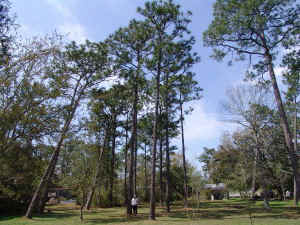
Longleaf Pine - Dad's Place 66' x 30' x 4'6" |
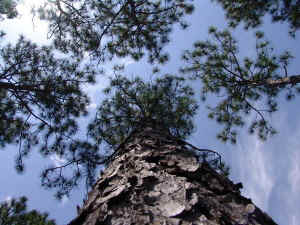
Longleaf Pine Crown |
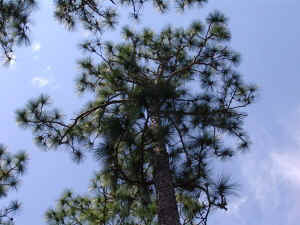
Longleaf Pine Crown |
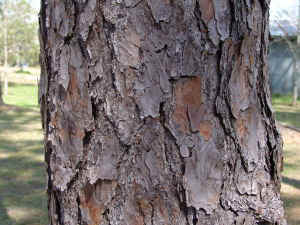
Long Leaf Pine bark |
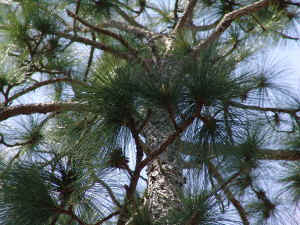
Longleaf Pine Needles |
|
The Property, although small just 1 acre, contained
many Pines. We lost approx., 50 from Hurricane Frederic(1979),
Hurricane Elaina(1985), Hurricane Georges(1998) and the latest
monster
Hurricane(Katrina)! The first three Hurricanes, Eyes went right
through our property and yours truly rode them all. (What a rush) to
old for that now! During Hurricane Georges my younger Brother and I
heard the C-130 Hurricane Plane right before we saw the Eye Wall! We
could look up and see the curvature of the Eye, a very rare
acurrance.
For we were in the Eye Wall! Six hours the storm remained
stationary, then shifted Northeast into Ala., boy were we happy! I
could tell many stories about Hurricanes, Storms, etc. The Longleafs
have endured much between Storms and Man, yet here they stand! We
stand with them! Very few Longleafs remain this far South! It must
have been an Awesome sight when most of the Forests, were Longleaf!
I'll post some photos on the file page.
Larry
== 2 of 11 ==
Date: Sun, Mar 23 2008 2:06 pm
From: Gary Smith
Larry,
I think an inventory of pines was done in some areas of coastal
Mississippi after Katrina.
This is from memory, but I'm thinking approximately 70% of longleaf
were still standing after the storm.
Loblolly pine didn't do nearly as well. I'm thinking something on
the
order of 30% made it. I drove by some planted loblolly stands north
of Kiln after Katrina and it looked like even less than 30% made
it.....vast fields of loblollies snapped in half like matchsticks.
Gary S
p.s. If you ever go east of Mobile, do a google search on the
Flomaton
Natural Area, near Flomaton, AL. This is a small stand (60 acres?)
of
old growth longleaf right off a highway. They were battered by
Hurricane Juan, but roughly 50% made it, I believe. There are
probably
some you would like to measure.
== 3 of 11 ==
Date: Sun, Mar 23 2008 2:26 pm
From: "Neil Pederson"
ENTS,
I'm very sorry to report that the Flomaton Tract, the last patch of
old-growth in lower Alabama, was clearcut in January. It was hit
hard by a
hurricane some time back and then the current landowners
"divested"
themselves from the tract. It was soon clearcut. Before that, it was
being
eaten at its margins for road-widening. Fire was being restored to
the patch
of old forest and thinning from below was conducted to make it look
like a
pre-settlement forest by John Kush and Auburn University. But, it
hadn't
been taken care of in the 50 yrs leading up to these efforts.
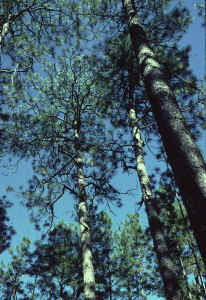
Flomaton Virgin Longleaf - Escambia Co., Alabama. -
G. Folkerts |
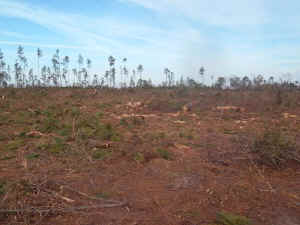
Flomaton Tract January 07, 2008 |
Attached are before and after pix and below is a brief report.
neil
*From:* John McGuire [mailto:mcguijo@gmail.com]
*Sent:* Friday, January 25, 2008 4:08 PM
*To:* jmcguire@westervelt.com
*Subject:* Fwd: Last to Fall--old growth longleaf
>>> 1/21/2008 2:50 PM >>>
Sometime, this past week, the last old-growth longleaf pine forest
in lower
Alabama was cut; just east of Flomaton. The 60-acre area was well
known, well researched, and well used. What made this forest
biologically
unique is that it was well over 3 centuries old and was among the
last
parcel of land of its kind in the world (only a few other virgin
longleaf
pine stands remain across 9 southern states; and now no more of its
kind in
Alabama). To put it another way, this one forest was over 100 years
old
before Alabama became a state in 1819.
The original owner of the tract in the early 1900's was
Alger-Sullivan
Lumber Company and the owner set it aside on purpose (having cut
everything
else around it). Local folklore indicates this owner called it the
"hell
freezes over area"; which were the conditions under which he
would have cut
it. Since then, the property has changed hands several times; all to
large
timber companies. Due to its rarity, these forestry companies
continued
to preserve the location as natural area significant to Alabama and
the
Southeast. In 1963, the National Society of American Foresters (SAF)
designated it as E. A. Hauss Old Growth Longleaf Natural Area. The
SAF's
definition of a natural area is "a tract of land set aside to
preserve
permanently in unmodified condition a representative unit of virgin
growth
of a major forest type, with the preservation primarily for
scientific and
educational purposes". The area was used extensively by local
4-H clubs,
civic groups, etc. In 1998 when the adjacent state highway was
widened,
Champion International offered the trees removed from the ROW to
Colonial
Williamsburg to restore historic buildings due to the scarcity of
old growth
longleaf pine timbers. Also, Auburn University School of Forestry
used
the area for over a decade to study the conditions of longleaf pine
forests
in their most primal state. It was later renamed the Flomaton
Natural Area
see:
http://www.forestry.state.al.us/publication/TF_publications/tffall99/flomation_natural_area.pdf
It seems that the tract was recently divested by Resource Management
Services out of Birmingham to an adjacent landowner who then
clear-cut the
area and sold the old logs. RMS purports to have contacted various
conservation organizations to see if they had an interest in buying
the
property.
== 4 of 11 ==
Date: Sun, Mar 23 2008 2:36 pm
From: Gary Smith
Very disappointing.
gs
== 5 of 11 ==
Date: Sun, Mar 23 2008 3:18 pm
From: Larry
Gary, Neil I knew about the Flomaton Tract, I read about it on The
Longleaf Alliance. Neil, thanks for that report, it's a shame that
no
one protected the only Virgin Longleaf Pine Tract in Ala.,! I'll get
down to Eglin sometime and see how large they are in there. I went
to
Blackwater State Forest near Milton Fla., but those young pines, 80
footers 4-5 CBH
== 6 of 11 ==
Date: Sun, Mar 23 2008 4:49 pm
From: DON BERTOLETTE
Neil-
It looks like the hurricane did quite a number on the tract! It
would seem inaccurate to say that it was clearcut after such a
devastating hurricane...perhaps there is more to the tract than what
is pictured?
-Don
== 7 of 11 ==
Date: Sun, Mar 23 2008 5:03 pm
From: neil
Don,
It was cut in January. That is not the result of the hurricane.
Please
read the report at the end of the first email.
neil
== 8 of 11 ==
Date: Sun, Mar 23 2008 5:11 pm
From: DON BERTOLETTE
Neil-
I looked through the posts and tried to find somebody to blame...I
met the enemy and it was us...we didn't do anything about it, just
trusted it was in good hands...so sad!
-Don
== 9 of 11 ==
Date: Sun, Mar 23 2008 5:22 pm
From: neil
yeah, it is pretty sad. it wasn't a perfect longleaf pine stand, but
the trees were old. there were efforts to get the state and others
to
protect the land - no one came up with the dough or legislation.
neil
== 10 of 11 ==
Date: Sun, Mar 23 2008 9:12 pm
From: Gary Smith
ENTS,
It is really sad that something wasn't done to save the Flomaton
tract.
With the openings created in the tract by Katrina, the surviving
mature longleafs would have seeded in the openings and combined with
periodic burnings to keep out the hardwoods and competing pines, and
to encourage the grasses, a classic uneven aged longleaf pine forest
would have eventuated itself, in my unschooled view from the cheap
seats.
Gary
== 11 of 11 ==
Date: Sun, Mar 23 2008 9:22 pm
From: James Parton
Larry,
I have never had the opportunity to have trees as really long-term
friends. To grow up with them. I have moved around too much over the
years. It is cool to see those Longleafs grow up over your lifetime.
At my home I have done a fairly detailed report on the forest behind
my home. Here it is White, Pitch and Virginia pines instead of
Longleaf.
http://www.nativetreesociety.org/fieldtrips/north_carolina/paris/paris_woods.htm
James Parton
==============================================================================
TOPIC: Longleaf Photos and Live Oak Photos
http://groups.google.com/group/entstrees/browse_thread/thread/92ea4e555e7f473b?hl=en
==============================================================================
== 1 of 3 ==
Date: Tues, Mar 25 2008 7:13 am
From: Larry
ENTS, I just posted mulitple photos of the Longleaf Pines I
measured last weekend. I also posted the latest Live Oaks in Pass
Christian. The photos are on the file page. Larry
== 2 of 3 ==
Date: Tues, Mar 25 2008 10:51 am
From: Gary Smith
Nice photos, Larry.
Interesting fact that the needles of young longleafs are definitely
longer than the needles of mature trees.
I guess the longer needles on a small longleaf affords those
terminal
buds a little more protection from fire and other dangers. Any other
theories? Am I missing something obvious?
Gary S.
== 3 of 3 ==
Date: Tues, Mar 25 2008 11:12 am
From: Larry
Gary, I do know that when they are in the Grass Stage the Needle
Cluster protects them from fires. They remain in this stage for 7
years while they grow their tape root. I guess this is why timber
co.,
don't like to grow them, to
slow.
The growth rings are incredibly tight for a Pine, one sixteenth-one
thirty-second an inch per year! Awesome! Strongest Pine timber in
the
world!
I've seen some long needles on Teenager trees but have never seen a
mature Longleaf (200 years+). I need to get a Coring Tool for aging,
that would be Way Cool!
Larry
==============================================================================
TOPIC: Longleaf Photos and Live Oak Photos
http://groups.google.com/group/entstrees/browse_thread/thread/92ea4e555e7f473b?hl=en
==============================================================================
== 1 of 11 ==
Date: Tues, Mar 25 2008 3:50 pm
From: James Parton
Gary,
I have noticed the same on Slash and Loblolly pines. It seems the
needles are longer on younger trees on those species too.
James P.
== 2 of 11 ==
Date: Tues, Mar 25 2008 4:37 pm
From: Gary Smith
James,
Another thought I have as to the reason for the extra long needles
when young is that it helps young pines gather more light when they
are competing with other plants for that ultimate space in the
canopy.
Let me know if my theories are getting totally nuts. lol
Gary
== 4 of 11 ==
Date: Tues, Mar 25 2008 4:50 pm
From: "Edward Frank"
Gary,
It is unlikely that what seems to be simple adaptations - like
growing longer needles on young trees - are a result of a single
process, but are an amalgam of whatever pros and cons any physical
or biological change that has taken place. So saying a tree grew
longer needles to protect from fire is almost assuredly not the
entire story of why the needles are longer.
Ed
== 5 of 11 ==
Date: Tues, Mar 25 2008 5:39 pm
From: Gary Smith
Ed,
Agreed, and I never meant to give the impression that there is one,
simple reason why the needles on a young pine would be longer than
the
same on a mature pine.
Still, I got to believe that more protection from fire for the
terminal bud, at least in the case of longleaf, and increased light
gathering ability of longer needles when competing with other young
trees most likely play at least a teensy-weensy role in the
equation.
My $.02, which is most likely overpriced. :-)
gs
== 6 of 11 ==
Date: Tues, Mar 25 2008 5:44 pm
From: "Edward Frank"
Gary,
I was agreeing with you that there were likely more than one reason
for longer needles - you suggested they were able to catch more
light as well as provide protection from fire.
Ed
==============================================================================
TOPIC: Longleaf Photos and Live Oak Photos
http://groups.google.com/group/entstrees/browse_thread/thread/92ea4e555e7f473b?hl=en
==============================================================================
== 1 of 4 ==
Date: Wed, Mar 26 2008 5:29 am
From: Will Fell
Larry;
I had not noticed the needles while in the grass stage to be longer.
It is possible that they are longer while the tree is in a rapidly
growing state and it may also possibly be a little illusionary as
the
needles are closer to you. I checked some behind the house and
couldn't find much difference between the old and young. There can
be
considerable variation among individuals and I have also noticed the
the further north you go up the east coast and west on the gulf
coast
the shorter the needles get. Also the Montane Longleaf in NE Alabama
and NW Georgia also have shorter needles, perhaps an adaptation to
more risk of ice.
The timber companies didn't plant them because bareroot survival was
so pitiful and undependable. Also they were somewhat slower growing
and the companies were looking for fiber rather than solid wood
products. Where they had deep sand they planted sand pine as it was
as
easy as slash or lob to plant. Since containerized seedlings came
out,
the companies are planting LL on sand that is over two foot deep. If
the sand is over five or six foot, they are still planting sand pine
as even LL won't do anything on that. Some of the west gulf and
carolina sawmill companies did actively manage for LL because of
it's
denser wood. T R Miller in Alabama comes to mind. Around here Slash
grades out even better than LL and is the preffered log, but Slash
is
very limited in range to Fla and S GA
As for grass stage, under good conditions LL will come out of the
grass stage in two years. However on poor sites and heavy
compitition
it can stay seven years or longer, though without fire they usually
succumb to brownspot before that. The needles protect LL while in
the
grass stage as the bud is a ground level and the heat of the fire
passes over top of it. Also the bud itself is so large and well
sheathed it takes a lot of heat to cook it. The tree develops a good
tap root and shoots up rapidly in the first few years once it breaks
grass stage. It is vulnerable to fire while in this stage and
perhaps
the rapid initial growth is also an adaptation to get it out of
harms
way.
== 3 of 4 ==
Date: Wed, Mar 26 2008 9:20 am
From: Larry
Will, I noticed on some of the man made LL plantings that the
needles look a little different than natural LL. Seedlings from some
LL must be slightly different due to adaptations from locations?
Also
I know they can also cross breed. I found some unusual Pines in
Northwest Fla., that I think where half-breeds. I'll dig up those
photos. Larry
== 4 of 4 ==
Date: Wed, Mar 26 2008 10:23 am
From: "Paul Jost"
Larry,
I've noticed the same thing with white pine seedlings here. State
DNR
nursery seedlings have a longer, darker needle form than native
seedlings.
I suspect most of it is due to heavy fertilization and ideal
irrigation
during propagation. If the difference persists as the tree grows,
then I
would think the difference is the origin of the seed source, as you
had
suggested.
Paul
==============================================================================
TOPIC: Article about the longleaf pine forests
http://groups.google.com/group/entstrees/browse_thread/thread/6f0b25f96f5ea1f5?hl=en
==============================================================================
== 1 of 2 ==
Date: Wed, Mar 26 2008 10:33 am
From: EDWARD NIZALOWSKI
I always enjoy receiving National Wildlife. The April/May issue has
an article about the longleaf pine: "America's Forgotten
Forest" by Doreen Cubie (pp. 38 - 44). There is also a great
selection of bird photos.
Ed Nizalowski, SMS
Newark Valley High School
Newark Valley, NY
enizalowski@nvcs.stier.org
"For all the chatter about the Age of Information, what we are
really entering is the Age of Biology, and it is bigger than
anything we can imagine. . . . . We didn't invent nature. Nature
invented us. Nature bats last, as the saying goes, but even more
important, it's her playing field. We would be wise to learn the
ground rules and how to play them.
Ken Ausubel, Ed. Nature's Operating Instructions. [from his
Introduction]
== 2 of 2 ==
Date: Wed, Mar 26 2008 11:49 am
From: Larry
Ed, Thanks so much for that info I found it very interesting . The
link to that article: http://www.nwf.org/nationalwildlife/article.cfm?issueID=121&articleID=1579
Larry
== 4 of 5 ==
Date: Mon, Mar 31 2008 7:09 pm
From: Will Fell
I went out last week near my house and took several photos on
Longleaf
Pines of various ages and uploaded them to the file page. This after
the discussion of the needle length of Longleaf Pine. One of the
photos shows a Longleaf in the "grass stage". It is the
clump of green
in the center of the photo. Compare it to the clumps of wiregrass in
the foreground and right of the photo. I also added a few more
photos
of Dogwoods and Azaleas in Bloom down here. The Dogwoods are the
prettiest I can remember in years. The blooms were large and
flawless,
normally the dogwood blooms around this section are not this
brilliant.
|